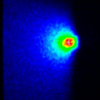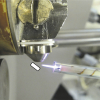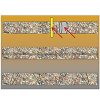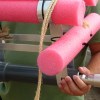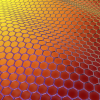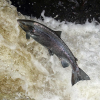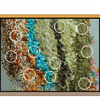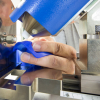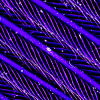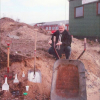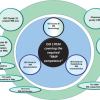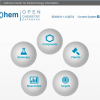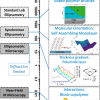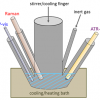Articles and Columns
Another surface problem is tackled by Richard Pilkington, Stuart Astin and John Cowpe: “Application of laser-induced breakdown spectroscopy for surface hardness measurements”. Measuring the hardness of materials is not entirely straightforward, and the authors show that laser-induced breakdown spectroscopy offers the potential for in situ hardness measurements, without prior sample preparation.
This article tells us about another: “Fast and versatile ambient surface analysis by plasma-assisted desorption/ionisation mass spectrometry”. They show that surface analysis can greatly benefit from approaches using surface–plasma interactions and that PADI shows significant promise to become a valuable and versatile tool for this.
Kim Esbensen and Claas Wagner’s Sampling Column also addresses issues around ensuring valid results, from the sampling perspective. “Composite sampling II: lot dimensionality transformation” continues to address the problem of heterogeneity and how to overcome it. If you can find a time when your bulk (3D) sample becomes a 1D sample, the job is possible. Interesting examples from unloading a grain ship to emptying a fishing boat hold are described.
In the Tony Davies Column, Tony looks at “Raman imaging of difficult surfaces”. He looks at a number of different approaches to dealing with uneven samples, as well as reviewing instrumental improvements that have made Raman imaging a viable analytical and diagnostic tool.
To ensure that the removal and treatment of our sewerage meets increasingly high standards, it is important to be able to monitor the water online both to provide timely information and also to establish changing patterns over days, weeks and seasons. In their article “On-line monitoring for improved wastewater system management: applications of ultraviolet/visible spectroscopy”, Rita Brito, Rita Ribeiro, Tatiana Arriaga, Catarina Leitão, Nìdia Lourenço, Filipa Ferreira and Helena Pinheiro demonstrate the value of on-line UV/vis spectroscopy for wastewater quality monitoring in decentralised wastewater treatment and for spectral on-line monitoring of key quality parameters at the inlet to wastewater treatment plants.
Graphene has been receiving a large amount of interest as its commercial possibilities begin to be realised. Now, with hundreds of companies offering commercial graphene production, analytical measures of graphene quality are required. Raman spectroscopy can be used to “understand the number of layers, strain, doping and importantly the level of disorder present in graphene”, which is described in this article: “Graphene characterisation and standardisation via Raman spectroscopy” by Andrew Pollard and Debdulal Roy.
In the “The analysis of poly aromatic compounds: a never-ending story?”, Peter Jenks reports from the 25th International Symposium on Poly Aromatic Compounds. He was disappointed to find the near total absence of mention of the use of CRMs in method development or as a calibration material. He concludes that “data from the academic and research community often acts as a stimulus for government concern and the data may ultimately may result in legislation. It concerns me that legislation may be driven by bad data”.
In the Tony Davies Column, Tony describes “A new approach to identifying unknown trace level analytes by tandem mass spectrometry without reference spectroscopic database support: CSI:FingerID”. This allows for tandem mass spectrometry data to be used to identify unknown analytes from common molecular structure databases where reference spectroscopic data is unavailable.
Fine sediments, often due to run-off from the land, can clog the surface and sub-surface spaces in gravel beds used by spawning fish to lay their eggs and by aquatic insects. Without an adequate flow of oxygenated water, the eggs and insects die. Heather Haynes, Susithra Lakshmanan, Anne-Marie Ockelford, Elisa Vignaga and William Holmes tells us about this in “The emerging use of magnetic resonance imaging to study river bed dynamics”. They have studied the infiltration of various sediments into model gravel beds both outside and flowing through a MRI instrument! They conclude that MRI “provides an exciting opportunity to unravel a plethora of processes relevant to wider environmental science”.
Kim Esbensen and Claas Wagner tackle the problem of heterogeneity in sampling and show how it can be dealt with at the primary sampling stage by “Composite sampling I: the Fundamental Sampling Principle”. As well as explaining the theory they also introduce practical solutions. Kim Esbensen and Claas Wagner tackle the problem of heterogeneity in sampling and show how it can be dealt with at the primary sampling stage by “Composite sampling I: the Fundamental Sampling Principle”. As well as explaining the theory they also introduce practical solutions.
In the Tony Davies Column, we learn about “Automated detection of counterfeit drugs using multimodal spectroscopy and advanced web-based software platforms”. With the increase in trafficking of counterfeit medicines and other products, there is a need for definitive results from an on-site analyser useable by customs officers. The German authorities have commissioned the development of a multi-modal, transportable inspection system, including intelligent data processing and evaluation, for fast spectroscopic recognition of illicit drugs and counterfeit medicines. This is described in the column.
Jürgen Gross has been using ambient mass spectrometry to look at the presence of polydimethylsiloxanes (PDMS) in food prepared in silicone rubber objects and on baking parchment. He shows that PDMS migrates into the food, something perhaps we should think about if in the mood for some baking!
Stanislav Strekopytov tells us about “The use of inductively coupled plasma mass spectrometry to quantify chemical hazards in natural history collections: arsenic and mercury in taxidermy bird specimens”. It is quite shocking to learn about the use of poisons to preserve taxidermy specimens in the past. Nowadays it is essential that the dangers from such specimens are known before they can be handled by museum staff and particularly if they might be touched by visitors. ICP-MS analysis provides fully quantitative information on bulk contents of toxic elements in taxidermy specimens and so is well suited to this task.
Mark Tobin and colleagues describe “Fourier transform infrared spectroscopy and imaging of dragonfly, damselfly and cicada wing membranes”. Insects and plants have evolved highly specialised surfaces such as being highly water repellent or superhydrophobic, which also confers self cleaning properties. This is of interest to materials scientists to help in the development of manufactured materials with similar properties. High spatial resolution FT-IR spectroscopy and imaging provide useful information about the complex chemical patterning that contributes to this functionality.
Kim Esbensen and Claas Wagner have gold on their minds. However, only to explain that “Sampling—is not gambling!”: the American “Gold Rush” of the late 19th Century is a good metaphor for the unrepresentative nature of grab sampling: something that you will soon realise is to be avoided in any sampling regime.
John Hammond updates us on “Reference materials: what’s new?”. The 2015 meeting of the ISO Committee on Reference Materials (ISO/REMCO) was held in June and significant developments in a number of standards that will ultimately affect all users of reference materials have taken place.
In the Quality Matters Column, Peter Jenks reminds us about “BERM 14: it’s that time again!”. The latest in this line of conferences on Biological and Environmental Reference Materials is being held in the USA in October 2015.
Tony Davies, Peter Lampen, Stephen Heller and Evan Bolton report on the future of the spectroscopic data collected as part of the EuroSpec programme. Its long-term preservation is being guaranteed through the PubChem Project of the US National Library of Medicine.
The authors describe “Infrared mapping spectroscopic ellipsometry”. Recent developments in fundamental and materials research have increased the value of mapping techniques such as ellipsometry. IR ellipsometry, since it operates in the mid-IR fingerprint region, provides complementary information on composition, structural properties and interactions
In situ spectroscopic methods such as infrared, Raman and UV/vis spectroscopy are powerful tools to gain insight into reaction mechanisms and catalyst actions in homogeneously catalysed reactions. These methods and combinations of them offer great potential for the real-time monitoring of reactions in the liquid phase, for mechanistic studies as well as process control and kinetics.

